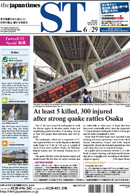Essay
Got a yen for yen?
Japanese people are lucky to have the coins they do. By size, color and with or without holes, they are easier to tell apart than many other countries' coins.
I have seen Japanese in Guam hold out a handful of American coins in a convenience store and ask the clerk to please take the right amount. I have also seen foreigners in Britain and Australia do the same with the local coins when buying drinks in pubs. It's just too confusing!
Here are a few facts about Japanese coins you might not know.
The 1-yen coin is the only one in the world that can float on water, if carefully placed. Because it's made of 100-percent aluminum, it's light. It also costs more to produce than it's worth, about 2 yen, but on the other hand, you can use the coins to measure weights since each one weighs exactly 1 gram.
For a hatsumode visit to a shrine in Japan, I did what many Japanese do and threw 5-yen coins into the offertory box because the word for 5 yen, go-en, sounds the same as "good or strong relations."
This coin has a hole in the middle, like the 50-yen coin. Some people think the holes are from ancient times to let people string the coins together to put around the neck or wrist. In fact, this is not true, since the coin designs are not that old. The holes save production costs, make them harder to counterfeit, and make it easier to tell apart just by touch. The 5-yen coin is also the only one with no Arabic numerals on either side.
I bet you don't have any 500-yen coins from before 2000 in your pocket or wallet. The first of these coins were first minted to replace the 500-yen banknotes in 1982. (My wife still has one of those banknotes for good luck). The big problem that followed was that the coin was exactly the same size as a South Korean 500-won coin, which at the time was only a tenth of the Japanese coin's value. People started using 500-won coins in vending machines in Japan — and the operators started losing money!
The Japanese mint changed the metals used in the coin in 2000, and vending machine operators had to change their machines to tell the difference between the Japanese and South Korean coins. Despite that hiccup, the 500-yen coin is one of the world's highest-value coins.
One final story: After World War II, the yen had no fixed value, so the U.S. occupiers in 1949 decided it should be 360 yen to the dollar. Why 360? Because yen means circle, and a circle has 360 degrees. Fact or urban myth? What do you think?
円は垂ぜんの的?
皆さんは普段使っている日本の硬貨についてどのくらいの知識をお持ちだろうか。日本の硬貨はほかの国と比べて区別がつきやすくていいという筆者が、日本の硬貨に関するトリビアを紹介する。
The Japan Times ST: June 24, 2016
The Japan Times ST 読者アンケート
この記事のご感想をお聞かせください。





